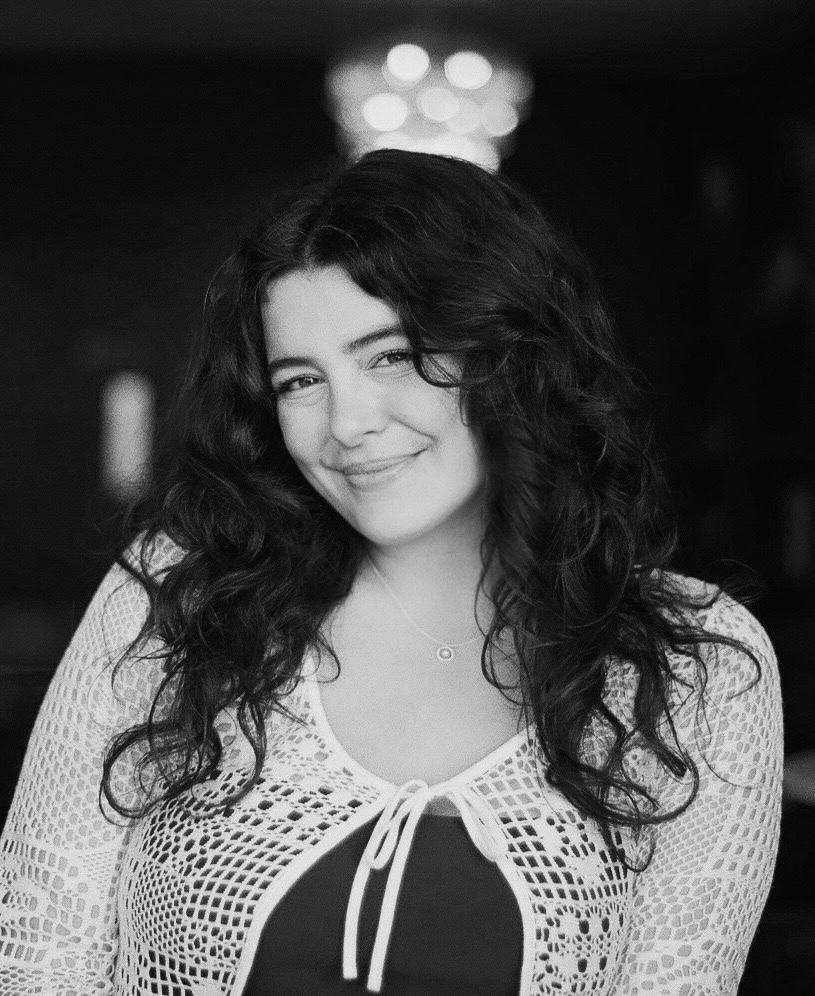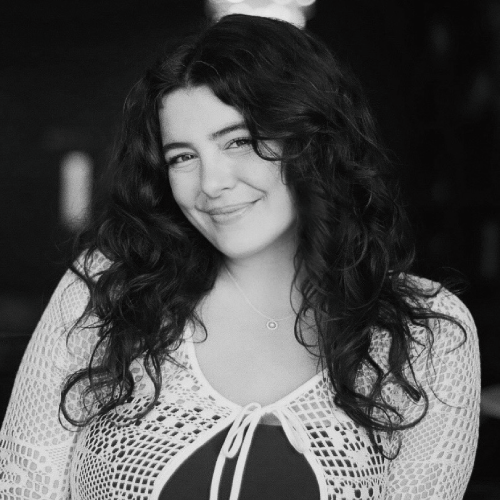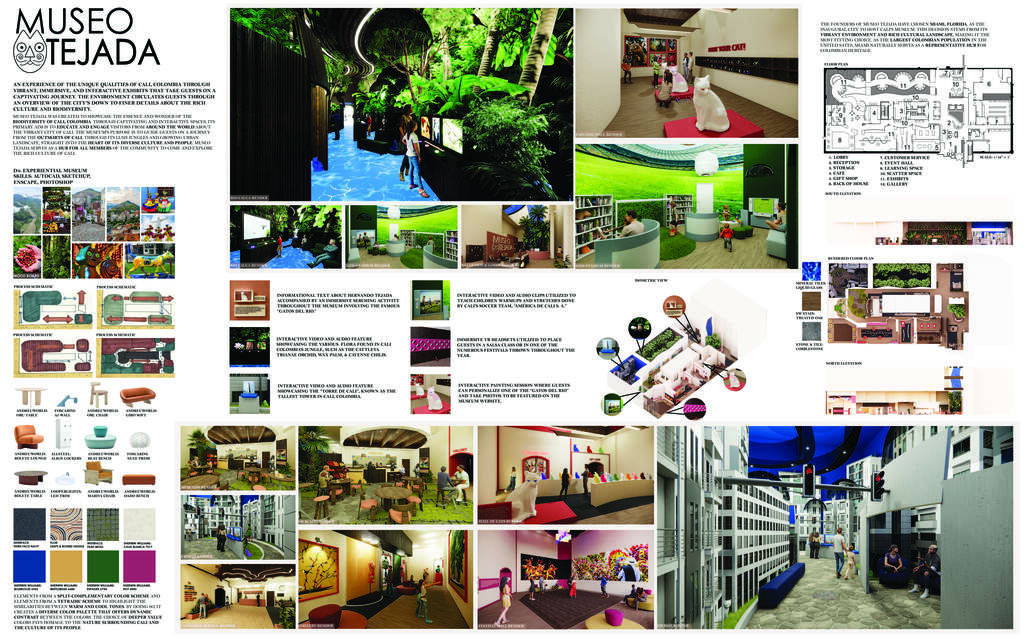

Samantha Blanco is currently a junior at the University of Florida. She is studying interior design as a minor and landscape architecture. At the time of her virtual exchange in interior design, she was a sophomore (a second year student). Samantha studied under the guidance of Luis Mejia, who we featured on our blog here.
Luis and his partner Edgar Martinez Muños from Cali Colombia, have run several successful virtual exchange iterations for their interior design programme. Students have collaborated to design interiors for a restaurant, a hotel lobby. In Samantha’s case, it ended up being rather an ambitious one!
A large scale virtual exchange task
“We got the museum programme for our virtual exchange and it was really a crazy one!’ laughs Samantha, ‘it was very large scale. But it allowed us to mould the space in such a creative way, so I think it was a wonderful opportunity to connect with the culture of Cali Colombia.”
She explains how they were put into small groups where they were tasked with conversing firstly among themselves as UF students to determine the best questions to ask the Cali Colombia students. The purpose of this task was to enable them to get the best and most useful information from their peers in Cali for the purposes of undertaking this project.
“We really wanted to represent Cali in the best way possible,’ she says,’ and we wanted to use different and immersive experiences to do that.”
The next phase was to reach out to the Cali Colombia students. They used WhatsApp for this phase. “We discussed our ideas back and forth with them. And we asked them what they were seeing and where they were at with their part of the task. They were so excited to see what we came up with.”
An Immense virtual museum space
“It was daunting when we first got the virtual exchange programme. I was quite new on the course at this point and I was really wondering how to tackle this. I began by analysing the floor space. With a space such as a museum, you need to take into consideration that you want to control as much of that experience as possible. So it was about moulding that interior architecture to facilitate the needs of the programme.
I had three or four separate main exhibits. My idea was a journey through Cali Colombia to illustrate how we see Cali from the grand scope right down to the more intimate details of the city and of their culture.
The exchange began with research about Cali really, and seeing what they – as a people – love to experience in the heart of their city. I began designing a big main street and gradually focused on the smaller streets branching off. Our project then entered a market and then a festival and then a gallery showcasing their art and history. It was a very multi-layered and diverse project.
I would say it was about analysing the citizens and finding the best way to showcase them to others and show them who they are.”
In terms of project guidelines, Luis and Edgar informed the students that they needed a certain number of exhibits and had to include various elements within it. These elements included a market and a reception. Samantha says it was a very loose programme and it was up to them to implement it as they best saw fit. But all students had to focus on the city of Cali.
“Having us all deal with the same city was interesting because you saw everyone’s creative interpretation of the city of Cali . Our teachers wanted us to focus on biodiversity too, and their vibrancy. Seeing how everyone explored and exploited that was fascinating as some had ideas I had not thought of and they were really beautiful too.
By all having the same city, we got to see a whole range of creative expression.”
Virtual end product
For the final virtual exchange product, Samantha says they built a model using a type of software for 3D design called Sketchup and another 2D one called AutoCAD – to develop their plan.

“We sourced furniture too, and material,’ she continues, ‘so it was a lot. Our final presentation included our floor plan and a 3D isometric of our overall model, renders and explanations of our process and our project. We had to include our ideas behind our material and our furniture. Essentially we did a board presentation consisting of the process in our project from start to end.”
Takeaways from the collaboration
“The best part of the project was being thrown into the deep end, she smiles. ‘Designing a museum has so much weight to it so it took me right out of my comfort zone. 30 ft ceilings is a lot to work with so it’s about how do we push and pull those moments and how do we make the experience smaller. We had to consider how to compress or enlarge those visual aspects.
Samantha clearly relishes a challenge!
I loved having my idea for design pushed further especially being new into the programme at that time. It was a great way to get an overall view of the environment. Not only that, but having the opportunity to collaborate with the students from Cali was really inspiring as well.
We got to see how they approach design too, because they did part of the project and we took on aspects of it too. It was inspiring to see how we could represent them and their thoughts behind their ideas.”
It was very satisfying for Samantha to learn from her teacher, Luis how in awe and happy the Cali students were with what they’d done.
“Having that connection for me was one of my favourite parts. I still talk about this virtual exchange experience to this day with anyone who will listen! I’m so grateful for this opportunity.”
Virtual exchange and self discovery
“I learned to trust the process with myself, says Samantha. ” I was nervous as that project was the final project ahead of an important admission selection process here at UF. So this project was going to be the star of the show. Professors were going to review it to see if you were good enough to move on to the next phase of the design programme. During this time, I learned to trust myself and my abilities and also trust in what my professors had taught me too.
I love to absorb information and I love to push myself and get critical feedback. We all start somewhere and we all end somewhere. In between, you’re allowed to make mistakes, you’re allowed to trip. It’s how you pick yourself up that really defines you as a designer. You can get feedback you don’t like. In these cases, you can choose to internalise that and let it get you down. Alternatively, you can internalise it and apply it to move onto the next phase.
Trust the process and you’ll end up where you are supposed to end up.”
Impact of the project on future plans
Samantha says she’s always wanted to go and work in Spain for a short period of time and this collaboration with Cali students showed her that’s what she wants for the future.
“I want to work for a firm that works like this – through collaboration with other people and cultures. I want to go abroad and meet as many people as possible.”
